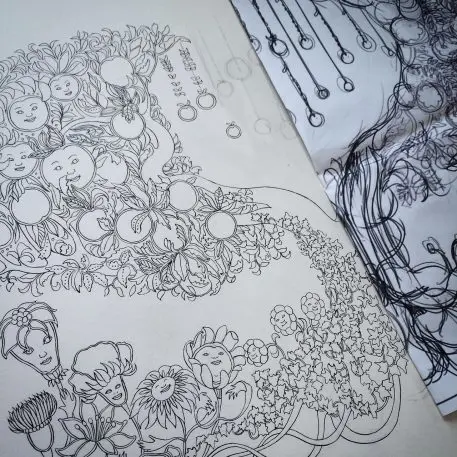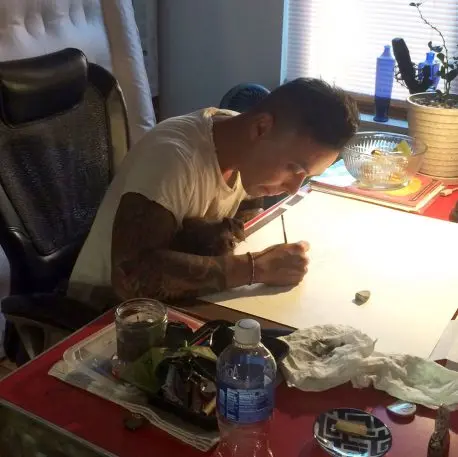When HarperCollins first approached me in 2015 about illustrating coloring books for adults, I was skeptical. The coloring fad had already become ubiquitous by then, as a kind of mental detox that could supposedly boost mindfulness and even improve mental health.
Personally, I wasn’t sure how true or false those claims might be. Despite being a freelance illustrator, the last time I’d actually colored in a coloring book was in grade school. What I did know was that my deadline-driven profession left me feeling stressed a lot of the time; it didn’t matter that it involved a lot of drawing and coloring.
But I agreed to give it a shot, and my first coloring book, Fairies in Wonderland, came out in 2016. I’ve since illustrated three coloring books. In the process I’ve learned a thing or two about the relationship between mindfulness and work, and how to inhabit the present when you aren’t the kind of person who’s particularly good at that.

Work Is Still Work . . .
While my work does involve coloring, I really hadn’t stopped to ask myself whether that (or any other) aspect of being an illustrator affected my mindfulness day to day. Long before illustrating my first coloring book, I’d been very aware that when I draw it sometimes feels as though the world falls away and disappears. I’m left in a space where the only thing I’m attuned to is the thing right in front of me–in most cases, the drawing I’m creating.
This type of deep focus is something lots of people struggle to get into, so in one sense, I feel lucky that it’s a natural part of my work. Our daily lives are full of distractions that make these single-focus states difficult to achieve, let alone inhabit on anything like a regular basis. Hence the appeal of an activity like coloring. Still, when I began working on my first coloring book, I certainly didn’t feel like I’d stepped into some hypnotic world; my job was to construct a space for others to enter their own. Focusing intensely on my drawing wasn’t exactly the same as meditating. In fact, it was the opposite—there was absolutely nothing mystical about it. It wasn’t rejuvenating at all; the work I was doing was simply work.
When I was younger, I clung to the typical romantic ideal about artists’ creative process, the notion that artists assume a totally different headspace for conjuring up their creations. But my process is nothing like that, just as many people’s work (creative or otherwise) often has to be pretty methodical and planned out in order for anything to actually get done.
For me, that first means deciding on a concept, then developing images that together form a coherent visual story. It’s a creative puzzle, to be sure, but solving it isn’t exactly a meditative experience. The drawings need to produce a kind of rhythm in the way they relate to each other as well as to the book as a whole, all while being able to stand on their own. In this sense, my approach to the coloring book was no different than were I illustrating a children’s storybook, or anything else with a series of sequential images. It was only after I’d built this framework and moved onto the decoration that the experience became—to my surprise—mindful.

. . . Except When It Lets You “Zone In”
The main thing that distinguishes coloring book illustrations from other types of illustration is their line-work. The more lines you introduce, the more nooks, crannies, and interesting shapes you give people to fill in with color. Getting the major shapes and figures down on the page was the first major design challenge, but with that done, I moved onto the more intricate, decorative elements. Working on those, I grasped immediately why some people love to color—how it can be relaxing, reduce stress, or even temporarily stave off sadness or depression. Personally, I worry too much and find that I spend a great deal of time mentally outside the here and now. (I tend to think of that as mind-wandering or daydreaming, or just indulging nostalgia; my therapist might call it “ruminating.”)
I find myself pining after things in the distance, whether it’s making enough money to pay off my credit card or being commissioned to work on a project that could propel my career forward. That means I’ve often got one foot in the future and the other planted in the past. Negative experiences tend to set me back, and I hang around in this psychological space for much longer than I’d like.
But to my surprise, working on the decoration in my coloring book helped me inhabit the present—and in a way that wasn’t as mentally taxing as just another deeply focused work session might’ve been. I felt like someone who’d actually color in the book might feel: soothed by the process of laying down colors within pre-defined areas. And as often happens, there were moments when I got lost in the act of drawing. In the past, I’ve used the term “zoning out” to describe this part of my process, where I forget the world around me, but more recently, I’ve re-termed it “homing in” or “zoning in” on the drawings I make. It’s a crucial distinction.
Like other mindfulness activities, the repetitive act of mark-making, and creating prints and patterns that fill a shape, encouraged me to become more deeply engaged in my creative process, right here in the present. It’s a form of focus, but not the kind that’s often so difficult to maintain. It’s much more meditative than the kind you’d use to pore over a data-heavy report or to block out distractions and bang out a project on a deadline.
True mindfulness—the kind that feels restorative and calming, anyhow—lies somewhere in the middle, I discovered, halfway between intense focus and zoning out. I get why people color, and I love creating the images that inspire them to. Finishing the drawings for my first coloring book, I felt like I’d gained a kind of respite from the scattered thoughts and feelings that tend to distract me—like so many others—from living in the present.
Marcos Chin is an award-winning illustrator whose work has appeared as surface and wall designs, on book and CD covers, and in advertisements, fashion catalogues, and magazines. He has worked with MTA Arts for Transit, Neiman Marcus, Fiat, Budweiser, Time, Rolling Stone, Fast Company, the New Yorker, GQ, Sports Illustrated, and the New York Times, among others.
Recognize your brand’s excellence by applying to this year’s Brands That Matter Awards before the early-rate deadline, May 3.
